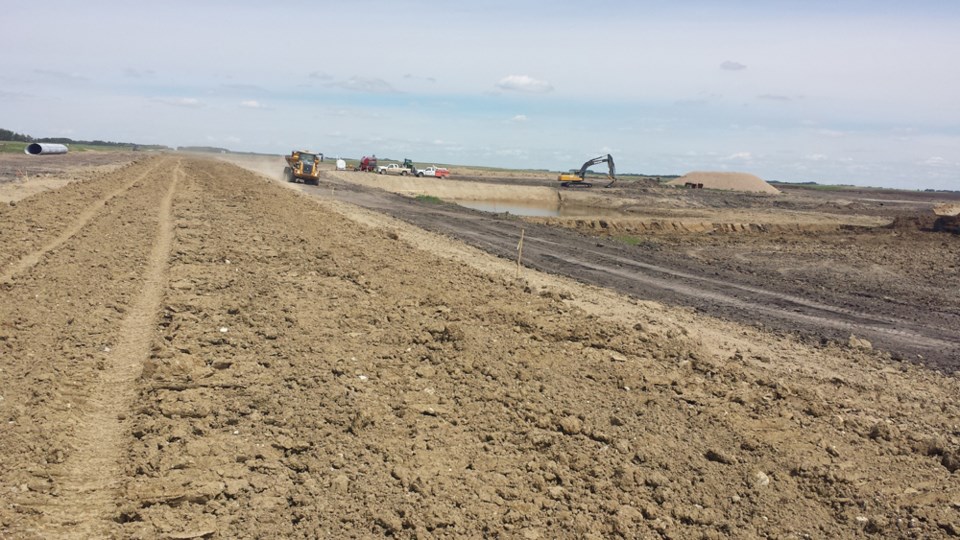With 85 per cent of the earth work complete, the Regional Authority of Carlton Trail (REACT) LeRoy landfill is now 75 per cent complete and is on track to reach its June 1, 2018 opening.
REACT CEO Wendy Yaworski says the run off pond, first garbage cell, and fencing is complete with only the buildings remaining to be built.
The construction has been tendered out and work can continue into the winter months as long as the contractors want to keep on going.
“Our concern and our goal is just to have it open June 1.”
This opening will also be coordinated with the Humboldt landfill since it will become a transfer station as soon as the LeRoy site is opened.
“There are still a lot of questions about whether (the public) can haul household garbage out to the Humboldt site. So the garbage cells will be shutting down but we’ll still accept household waste,” says Yaworski.
Household garbage received at the Humboldt site, including small renovation projects and grain bags, will be received at the Humboldt site and transferred to the LeRoy site.
Large renovations will have to hauled to the LeRoy site.
The landfill project did cause a stir when it was proposed back in the spring of 2016 (http://www.humboldtjournal.ca/news/local-news/new-landfill-site-sparks-municipal-debate-1.2230179), and those living near the landfill will always have concerns, says Yaworski.
“We’re going to try to keep as close to the operating plans as we can for litter control, better control over managing the site.”
REACT will continue to work with those families on mitigating any concerns and once the site is open, Yaworski says they will be forming a liaison committee with local landowners as an effort to keep them updated.
Right now, there is not a lot to update the public on since the project focus so far has been the earthworks, says Yaworski.
As they stand financially, the project is budgeted at around $4 million. As work continues, some aspects of the project have been coming in over budget while others have been coming in under budget. Yaworski says they do not know how much the buildings are going to come in at but they will have a better idea on the total cost of the project in the next few months.
“Most projects like this tend to run a little bit over but it’s looking not too bad right now.”
Funding for the project is going to come from the per capita levies from member municipalities who own REACT, including 31 urban and 16 rural municipalities with 26,000 individual members.
Currently, the project levy is set at $155 per person for five years with the levy being scratched after that, says Yaworski, as well as an ongoing $25 per person operation levy.
Even if the project cost changes, that project levy will remain at $155 as set by the REACT board. Municipalities will also not be paying interest on the loan that REACT secured to go ahead with construction on the project.
“As difficult as it is, we’ve tried to keep it as low as possible for the member municipalities. We’re not a haul company where it is for profit. They own REACT, we’re just an extension of the member municipalities.”
With the newness of the project comes a chance to set high standards for the operation of the landfill and Yaworski says they are excited to have one of the better run landfills in the province.
Solid waste is the priority for the Ministry for the Environment who is working on decommissioning obsolete landfill sites across Saskatchewan. So far in the last couple of years the number of landfills have gone from 563 to 256 with over 300 sites being closed down with plans to decommission the site.
“Their goal for the next few years is to reduce that another 50 per cent.”
The ministry is starting to focus on converting to regional waste authorities, says Yaworski, so these member municipalities run operations are already a step ahead of the rest of the province.
While it is not being closed down, the Cudworth landfill site is far from being up to code for waste management standards and that is another project for the future, says Yaworski.
As they work to build a new cell for waste disposal, as well as more berms, in order to upgrade the site.
All of this is coming to a cost, says Yaworski, with a new garbage cell costing $500,000 to engineer.
Taxpayers own the landfill which is why this is also a good reason that people should keep as much recyclable material out of the landfill as possible, says Yaworski.
“It’s to everyone’s benefit to keep as much recycling out of the landfills as you can.”
The new landfill is set to last anywhere from 70 to 100 years.




